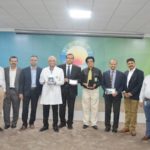- World Myopia Awareness Week (23rd -28th may 2022)
- High Myopia Significantly Increases the Chances of Cataracts, Glaucoma and Retinal Eye Detachment
India
healthysoch
Mumbai/Chandigarh, May 23, 2022 :
Myopia or near-sightedness is a vision condition in which people have difficulty seeing objects that are far away but the close-range vision remains sharp. It is one of the major public health concerns around the world, with a prediction that nearly 50 per cent of the global population will be myopic by 2050. In India, the diverse geo-biological variations along with genetics and various social factors play an important role in the development of myopia.Researchers have found out that myopia often leads to an abnormal increase in axial length. When the axial length grows to more than 25mm, especially with age, problems like cataracts or glaucoma can appear.
The pathologic changes are likely to increase drastically overthe next few decades, largely contributed by the ageing effect where young adults who have high rates of myopia(80–90%) in urban Asian cities will grow older.
Choroidal thinning at sub-foveal, macular and peripapillary region has been reportedto be associated with various myopic pathologic lesions such as choroidal neovascularisation, lacquer cracks, staphyloma and chorio-retinal atrophy. Advances in ophthalmic bio-imaging modalities have enabled the identification of the fine details of structures and allowed the prediction of risk factors.
Earlier studies suggest that, thinner Bruch’s membrane in highly myopic PCG eyes may make it easier for neovascular vessels to penetrate and result in CNVM.
Different studies and reports indicate that myopia is common in old-aged people with the prevalence rates ranging from 15 per cent (in those who are 49 or over) to 38.7 per cent (in people aged 40-79 years). High myopia is often associated with cataracts and cross-sectional data available from the Blue Mountains Eye Study has shown that there is an association between nuclear and posterior sub-capsular cataracts and myopia. The density of the cataract was higher in the high myopia group. No association was observed between PSC or cortical cataract and high axial myopia.
“A high degree of myopia is also related to the development of primary open-angle glaucoma. It is estimated that almost 10 per cent of blindness in the US can be contributed to primary open-angle glaucoma. Today, children as young as six are developing myopia and are likely to become highly myopic. The risk of open-angle glaucoma along with other ocular diseases are increasingly becoming a threat to the young population, and ophthalmologists need to be aware to detect them and treat the disease in the early stages” said Dr. Jitendra Jethani, Paediatric Ophthalmologist at Baroda Children Eye Care & Squint Clinic and Medical Advisor for Entod Pharmaceuticals.
Depending on the age of the person, the severity of myopia and geographical setting, the disease can have severe socio-economic consequences on the person. Myopia can badly impact a person’s early life, imposes disability and is life-long.In 2015, uncorrected myopia caused $244 billion of potential lost productivity worldwide as per studies.
It was found that the leading cause of monocular blindness was myopic macular degeneration among the patients with visual impairment.
“Presently, the costs related to health expenditure and lost productivity because of myopia around the world are in the range of several hundred billion dollars every year. Shifting the trajectory needs a coordinated global effort and it is good to see that significant success has been made with regard to optical, environmental, and pharmaceutical strategies to prevent the onset and/or slow down the progression of myopia. From LASIK surgery to Phakic intraocular lenses to intraocular lens implants and more, there are plenty of ways through which myopia can be treated.
However, early and appropriate interventions are crucial as they can mitigate the risks and consequences related to myopia. More importantly, it can lessen the risk of the eye progressing to higher levels of myopia and thus have a positive impact on reducing the burden” said Nikkhil K Masurkar, Executive Director of ENTOD Pharmaceuticals.
“It is equally important that future policies and research are undertaken to address the existing limitations with novel concepts so that the future crisis can be handled better” he added.
healthysoch







